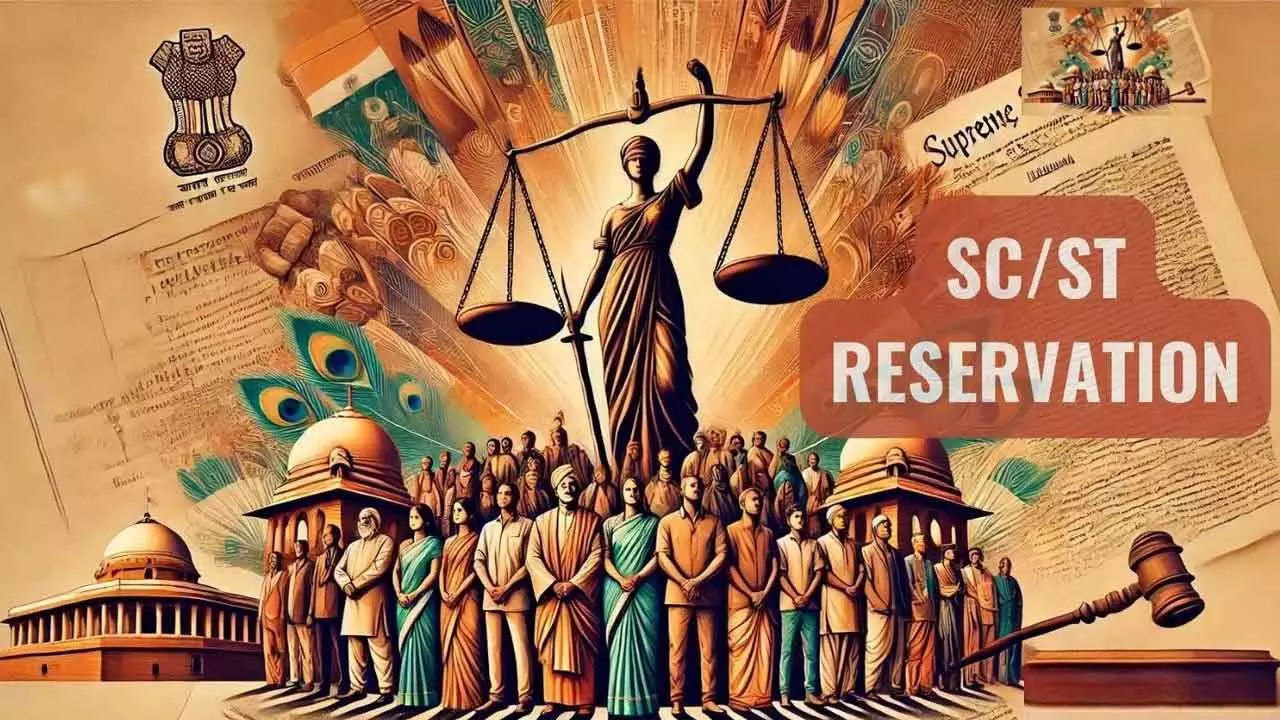Live
- They always want me to win, and now I feel lucky to have been offered a story like ‘Zebra’: Satyadev Kancharana
- ‘Democracy first, humanity first’: PM Modi in Guyana's parliament on two countries' similarities
- PKL Season 11: Telugu Titans register third straight win to top standings
- Is Pollution Contributing to Your COPD?
- NASA Unveils Underwater Robots for Exploring Jupiter's Moons
- Additional Central forces arrive in violence-hit Manipur
- AR Rahman and Saira Banu’s Divorce: Legal Insights into Common Issues in Bollywood Marriages
- 82.7 pc work completed in HPCL Rajasthan Refinery area: official
- Curfew relaxation extended in 5 Manipur districts on Friday
- Tab scam prompts Bengal govt to adopt caution over fund disbursement
Just In
Landmark verdict on deepening affirmative action


Coming to the aid of more disadvantaged sections within SCs and STs in availing of government quota, a seven-judge Constitutional Bench led by the...
Coming to the aid of more disadvantaged sections within SCs and STs in availing of government quota, a seven-judge Constitutional Bench led by the Chief Justice by a 6-1 majority delivered afar-reaching verdict August 1 in favour of the states sub-classifying the lists of Scheduled Castes and Scheduled Tribes to impart inclusivity and ensure equitable distribution of welfare, be it education or jobs. Seizing the moment, Chief Minister A Revanth Reddy announced Telangana will be the first state in the country to implement the SC verdict.
Amidst increasing unemployment and growing uncertainty in private sector jobs, there is feverish race for government employment for the security and steady growth it offers. Besides, among the reserved categories themselves, better-offs have been leaving worse-offs so far behind that a demand for sub-categorisation has been growing strong for over four decades. Punjab had in 1975 itself recognised the need for sub-quotas and introduced 50 per cent quota within the SC quota for Mazhabi Sikhs and Valmikis. However, the Punjab-Haryana HC in 2010 ruled against the order, basing its judgement on that of a five-judge bench of the SC in 2004.
The only dissenting judge, Justice Bela M Trivedi, opined the states have no legislative competence to enact the law for providing reservation or giving preferential treatment to a particular caste/castes by dividing/sub-dividing/sub-classifying or regrouping the castes, races or tribes enumerated as the ‘Scheduled Castes’ in the notification under Article 341. Earlier, a five-judge bench of the top court in the EV Chinnaiah v State of Andhra Pradesh case in 2004 had said creation of sub-quota did not stand constitutional scrutiny. It ruled that all castes in the Presidential Order under Article 341(1) formed one homogeneous group and could not be subdivided further. Further, Article 341 of the Constitution empowers only the President to identify SCs through public notification.
Justice Trivedi upheld the 2004 ruling. However, the majority judges backed sub-classification, thus reversing the said ruling. Chief Justice D Y Chandrachud observed their verdict does not violate either Article 14 or 341 of the Constitution. The judgement stressed that sub-categorisation, carried out on the basis of authentic data and scientic study, would make the SC/ST quota more inclusive.
TDP is naturally elated as it was the N Chandrababu Naidu government that enacted a bill on SC categorisation into A, B, C, D groups with reservation in the ratio of 1, 7, 6, 1 per cents respectively in 2000, a year after its ordnance on the matter was challenged in the court. While the High Court dismissed petitions against it, a five judge bench of SC in 2004 ruled that States had no right to sub-classify the SCs.
The latest verdict, however, doesn’t cover Central government as there has been no demand. Moreover, with over 1,000 SC and 700 ST communities out there, many of them being state-specific, it is next to impossible for the Centre to take up such an exercise. Same would apply to higher educational institutions, varsities under central government rules.
At the end, it is to be noted that four of the seven top court judges felt there is a need for exclusion of creamy layer from SC/ST reservation benefits i.e., affirmative action policies, as in the case of OBCs, so that underprivileged sections get more opportunities for government benefits. On the whole, the crux of the judgement is more judicious application of affirmative action, well explained by Justice B R Gavai thus: “It is the duty of the State to give preferential treatment to the backward class of citizens who are not adequately represented.”

© 2024 Hyderabad Media House Limited/The Hans India. All rights reserved. Powered by hocalwire.com






